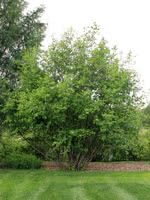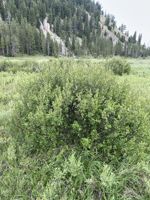Mon-Fri 9am - 5pm Mountain time
Green Alder vs Dwarf-Bog Birch
Alnus alnobetula subsp. crispa
Betula glandulosa
COMING SOON
CUSTOM GROW
Green Alder is a native, cold-hardy shrub found in boreal forests, along slopes, and in open upland habitats. It fixes nitrogen in the soil, improving fertility and helping other plants grow, while its roots help stabilize slopes and disturbed ground. Fast to establish on poor soils, it is widely used in reclamation, restoration, and erosion control projects.
With its smooth grey bark and shiny green leaves, Green Alder often forms dense thickets that provide cover for birds and small mammals. Its seeds, buds, and catkins also supply food for wildlife. Green Alder is well suited for naturalization and ecological restoration.
Note: We use Green Alder for Alnus alnobetula subsp. crispa. This species is also known by many other common names, including Mountain Alder, Sitka Alder, and others. Please confirm the scientific name to ensure you are ordering the correct plant.
Dwarf-Bog Birch is a native, cold-hardy shrub that can be found across most of Canada. Its preference for moist soils and the extensive root system make it well-suited for riparian zone plantings, soil stabilization, and erosion control projects.
It features small, round, leathery leaves with scalloped edges and produces small, cone-like catkins. A distinguishing characteristic of the Dwarf-Bog Birch is the presence of large resin glands on the branches and the undersides of the leaves. These resin glands are the reason for its scientific name, Betula glandulosa.
Note: We use Dwarf-Bog Birch for Betula glandulosa. This species is also known by many other common names, including Bog Birch, Dwarf Birch, Glandular Birch, and others. Please confirm the scientific name to ensure you are ordering the correct plant.
Green Alder Quick Facts
Dwarf-Bog Birch Quick Facts
In row spacing: 0.9 m (3 ft)

